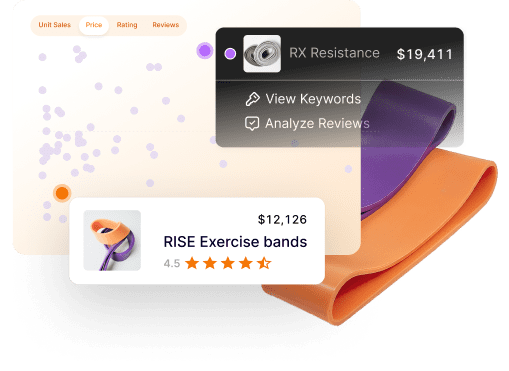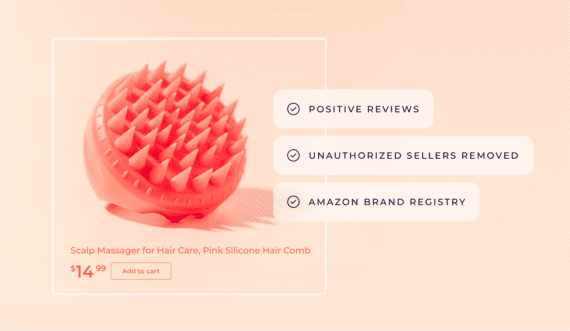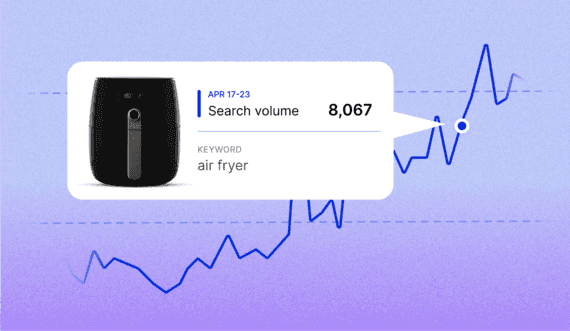Selling on Amazon is more competitive than ever. Experienced sellers understand that basic product research only scratches the surface of what’s needed to succeed now in the marketplace — advanced Amazon product research techniques are essential for uncovering profitable, high-demand products in saturated markets.
This data-driven approach gives sellers the insights to stay ahead of trends, increase revenue, and maintain a competitive edge.
Whether you’re looking to refine your existing product offerings or find new opportunities, advanced research tools can offer the depth and precision needed for success.
What does “advanced” mean in advanced product research?
Advanced product research goes beyond basic searches and keyword analysis. While regular product research may involve finding popular categories and high-volume keywords, advanced research digs deeper into sales velocity, profitability, and seasonality metrics.
This allows sellers to analyze historical data, identify trends, and make informed decisions based on competition and demand in specific niches.
Experienced sellers should focus on several critical data points during advanced product research:
- Sales velocity. The rate at which products sell over time. Fast-moving products signal high demand, but saturation can also be an issue. Analyzing velocity helps determine whether the demand justifies the competition.
- Profit margins. Evaluate costs, including cost of goods, packaging, shipping, and Amazon fees. Identifying high-margin products is critical to long-term profitability.
- Competitor insights. In-depth competitor analysis reveals pricing strategies, keyword targeting, and overall market positioning. Sellers can identify potential gaps in the market.
- Seasonality trends. Understanding the seasonality of certain products allows sellers to adjust their portfolios throughout the year, maximizing profitability during peak periods and avoiding stockpiles in low-demand times.
Advanced product research requires combining multiple data points to offer detailed insights that guide an Amazon seller’s decisions. This is one of the most important aspects of selling products on Amazon and online, so make sure you invest in the right products.
Examples of advanced product research vs. regular product research
The distinction between regular and advanced research lies in the data gathered and the strategic approach used. Here’s a comparison:
| Regular Product Research | Advanced Product Research |
| Focuses on broad category popularity | Analyzes historical data and sales trends |
| Uses simple keyword research for high-volume products | Uses tools to identify untapped niches and low-competition opportunities |
| Limited competitor analysis | Detailed competitor analysis, including pricing, growth trends, and market share |
| Focuses on immediate popularity | Considers long-term profitability and seasonality |
| Identifies products based on demand alone | Evaluates profit potential, margins, and sales velocity |
By leveraging advanced product research techniques, sellers can uncover underserved markets, make more informed product selections, and position themselves for long-term success.
Tips for identifying untapped markets:
- Analyze market trends. Use sales velocity and trend data to identify product categories or niches that are gaining momentum but aren’t yet saturated.
- Look for niche demand. Perform competitor analysis to find gaps where demand is rising, but competition is low. This is often where high-margin opportunities lie.
Conducting proper competitor analysis is very important during this stage of product research. Here, you will discover which competitors own the majority of the market, how customers feel about their products, and what can be done to improve the product under your brand.
Why advanced product research is essential for success on Amazon
Advanced research is no longer optional for experienced sellers looking to grow their market share—it’s a necessity. With competition fiercer than ever, staying ahead of the curve requires more than basic analysis.
Advanced research helps sellers:
- Anticipate trends. Sellers can be proactive rather than reactive by understanding emerging market trends and identifying seasonal shifts.
- Avoid saturation. While some categories may appear lucrative, deeper research often reveals oversaturation, leaving little room for new sellers to compete.
- Maximize margins. By targeting underexplored niches and factoring in hidden costs, sellers can maintain healthier profit margins while minimizing risks.
- Understand the competition. With competitor analysis, you’ll gain a deeper understanding of your competitors’ brands and products, giving you an edge when you launch your product in that market.
Emerging trends to watch for in 2025
As Amazon sellers look toward 2025, staying on top of emerging market trends will be crucial for maintaining a competitive edge. The following trends are expected to shape consumer demand and provide new opportunities for sellers:
- Sustainability and eco-friendly products. Products made from environmentally friendly materials, such as biodegradable packaging, reusable items, and sustainable alternatives in everyday categories (home goods, fashion), are growing in popularity. Sellers should look for opportunities to enter or expand in the eco-conscious market, offering sustainable options that align with consumer values.
- Health and wellness. Health-conscious consumers continue to drive demand for products in the wellness space. From fitness equipment to organic supplements, mental health tools, and wearable tech, products that promote overall well-being are growing rapidly. Sellers in this category can expect continued growth as consumers seek products that enhance physical and mental health.
- AI-driven tools. AI technology is increasingly becoming a part of daily life, driving demand for products that integrate with artificial intelligence. From smart assistants and AI-powered devices to tools that enhance efficiency, consumers are embracing AI to streamline tasks. Sellers exploring AI-driven products in this space will tap into a rapidly growing market.
Staying attuned to these trends through advanced product research ensures that sellers can fine-tune their product offerings and adapt to market shifts.
How to approach advanced Amazon product research
To perform advanced product research effectively, sellers need to consider several strategies:
From a sales data perspective
Comprehensive sales data analysis is the foundation of advanced research. Tools like Jungle Scout’s Product Database, Product Tracker, Competitive Intelligence, and Review Analysis provide detailed insights into:
- Sales velocity: Understanding how quickly a product sells in the market helps sellers gauge demand and avoid oversaturated categories. Sellers can view this information within the Product Database or Product Tracker.
- Customer reviews: By analyzing review patterns in Review Analysis, sellers can identify common pain points and opportunities for product improvement.
- Pricing trends: Monitoring pricing trends in the Product Database or Competitive Intelligence ensures competitive positioning while maintaining profitability.
From an opportunity perspective
Finding untapped markets is essential for long-term success on Amazon. Jungle Scout’s Opportunity Finder helps sellers discover underexploited niches with high demand and low competition. Capitalizing on these opportunities requires:
- Identify trends: By staying ahead of emerging trends, sellers can position themselves as market leaders in new categories. Sellers can use Opportunity Finder and pay attention to social media trends.
- Seasonality: Product portfolios should be adjusted according to seasonality, ensuring sellers maximize profits during peak times and reduce waste during slower periods.
From a product portfolio perspective
Optimizing an existing product portfolio requires a data-driven approach. Sellers should:
- Phase out underperformers: Products with declining sales or slim margins should be removed to free up resources for higher-performing items.
- Expand into new categories: Use advanced product research strategies to identify promising new categories, leveraging tools like Jungle Scout to minimize risks.
Balancing a product portfolio ensures sellers capitalize on profitable opportunities while avoiding over-investment in underperforming products.
5 steps to perfect your Amazon advanced product research practices
To help you get started with advanced product research for Amazon, here’s a practical, step-by-step approach using Jungle Scout’s suite of tools:
1. Use Product Database to find new product ideas
Jungle Scout’s Product Database allows sellers to find many product ideas in seconds by filtering product categories and other criteria, such as monthly sales, competition level, BSR, listing quality, and profit potential.
This helps identify promising products with strategic filtering options, ensuring you focus on the highest potential products.

Product Database also features preset filters to help users find profitable product ideas to sell on Amazon. For example, if you click the ‘High Demand’ filter, it will automatically populate the units sold filter to a minimum of 750 units sold per month.
Doing so filters out products that do not meet your specific product criteria. Play around with each filter until you find what settings work best for the type of product you’re focusing on.
2. Analyze competitor performance using Competitive Intelligence
Understanding your competition is critical to succeeding on Amazon. If you launch a product without knowing about the market size, your competitors, and their market share, you will have a tough time competing.
Jungle Scout’s Competitive Intelligence tool provides real-time insights into your competitors’ market share, sales velocity, and pricing strategies. This helps sellers stay ahead of their competition by identifying areas where they can outperform.

Competitive Intelligence also helps sellers identify trends in competitors’ reviews and provides them with actionable insights on how to improve a particular product or product listing.
With this information, you will be ten steps ahead of other competitors who are looking to launch products in a similar market.

3. Use Opportunity Finder to identify new trends and niches
Opportunity Finder is invaluable for spotting new, high-demand niches with minimal competition. Sellers can use this tool to find emerging markets and discover new product opportunities by searching for high-demand and low-competition keywords.
This tool allows users to easily view historical average units sold, average price, search volume, seasonal trends, reviews, and supplier details to evaluate product performance and market viability.
Similar to the Product Database, Opportunity Finder allows you to adjust many filters to find the best possible products to launch on Amazon.

4. Optimize listings with data-driven keyword research
Optimized listings are crucial for visibility within Amazon’s search results and for increasing your conversion rate.
Jungle Scout’s Keyword Scout helps you find the most relevant and high-volume keywords and provides valuable insights such as search trends, exact search volume, product categories, ease of ranking, and estimated PPC bids.

As you go through the keyword results, you can add the keywords you would like to use within your Amazon listing and PPC campaigns to a keyword list.

Once your list is complete, you can then import that keyword list into the Listing Builder tool in Jungle Scout. Using AI Assist, sellers can have Listing Builder write an optimized listing.

5. Track product performance with Rank Tracker
Consistently tracking product performance is key to making informed decisions. With Jungle Scout’s Rank Tracker, sellers can monitor changes in keyword rankings and identify top-performing keywords. Sellers can also use this tool to monitor their competitors’ organic search rankings for particular keywords.

Knowing where your competitors rank for the top-performing keywords will help you adjust your listings and PPC campaign strategies.
Unlock new product opportunities with advanced product research tools from Jungle Scout
Advanced product research is essential for experienced Amazon sellers aiming to stay competitive and grow. Jungle Scout provides the data and insights necessary to conduct in-depth research, adapt to market trends, and ensure long-term success.
By leveraging these tools, sellers can unlock profitable opportunities and take their Amazon business to new heights.
Brian Connolly is an Amazon seller, ecommerce expert, and writer for Jungle Scout. He lives in the New Jersey Shore area with his wife and cat. When he isn’t writing advice online for aspiring and experienced Amazon sellers for Jungle Scout, he spends his free time boating, fishing, and selling boating-themed items on his Amazon business.










